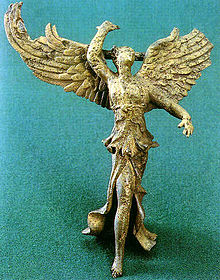Nike (mythology)
In Greek mythology, Nike (Greek: Νίκη) is the goddess of victory. She was often depicted as a small winged sculpture in the hand of another, more important god, such as Zeus or Athena, her ally. She presided over athletic contests and military disputes.
During the medical wars (the Persian invasions of Greece), after the Athenian victory in the battle of Marathon (490 BC), the story of the soldier who ran 42 km from the beaches of Marathon is known to Athens to announce victory, shouting "Nike!" ("Victory!"), and then collapse.
Hesiod made her the daughter of the Titan Pallas and Styx, being then the sister of Bia (Violence), Zelo (Fervour) and Cratos (Strength). Homer makes her, in a different version, the daughter of Ares.
Ares [...]. Olympus defender! Father of the bellicose Victoria (Niké).
The Temple of Athena Nike stands out in the Acropolis of Athens. She is usually represented with wings and carrying a palm or a laurel wreath. Known representations of Nike are the so-called Victory of Samothrace (currently in the Louvre museum) and the small statue in the hand of Zeus of Olympia, and other works from the Renaissance.
Her equivalent in Roman mythology was Victoria, whom Minerva (the equivalent of Athena in Roman mythology) was considered to have grown up with as a child.
Etymology
While the Greek word νίκη (nikē) has an unknown origin, R.S.P. Beekes has suggested a pre-Greek etymology. However, it has also been speculated that it derives from the Proto-Indo-European root neik, which means "to attack" or "to begin vehemently". If true, the word would coincide with Ancient Greek νεῖκος (neîkos, "conflict") and Lithuanian ap-ni̇̀kti ("attack").
Mythology
Nike often appears in literature associated with the god Zeus or the goddess Athena or even as a facet of their personalities. According to Theogony, Nike, Zelo, Cratos and Bia "will not live apart from Zeus, they will not travel unless the god does first, and they will sit forever beside the resounding Zeus." Nike and her brothers acquired these honorable positions due to their assistance to Zeus during the Titanomachy. During the war against the Titans, Zeus summoned all the gods of Olympus to determine their alliances and declared that any god who sided with him and against Cronus would receive his honor and her favor. Of all the gods, Styx and her children were the first to declare their allegiance to Zeus. While Styx earned "the great oath of the gods," her children were allowed to live with him forever. As a result, Nike is often depicted in literature alongside Zeus, in an honorable position next to her.
In Nono of Panopolis's Dionysiacs, Nike is described as an emissary of Athena sent to aid Zeus in his battle against Typhon. When the serpent-headed giant Typhon besieged Olympus in At the end of the Titanomachy, Nike reproached Zeus for his doubts about facing Typhon and urged him to gather his lightning bolts in preparation to defend Olympus. She in her speech mentions all the gods who had surrendered and fled from the battle like Ares, Hermes, Apollo, Aphrodite and Hephaestus. He also mentions the possible repercussions of a Typhon victory, such as the destruction of Olympus and the rape and enslavement of his daughters Athena and Artemis. The next morning, when Typhon continues his attack, Zeus shields himself from the clouds like armor and respond to threats from the monster. Nike, described as Victory, leads Zeus into battle, while Eris leads Typhon. During the battle, Nike uses her shield to protect Zeus, while he fights with lightning and freezing rain. With the help of fire and ice, Zeus was able to defeat the monster and declare victory over the Titans. As Zeus left the battlefield, Nike followed him driving his father's chariot. In the Theogony, this battle is variously described: neither Zeus was hesitating to face Typhon, nor Nike appears at no point in the fight.
Nike is also depicted in literature as a goddess who judges the excellence of gods and mortals in competition. Her role in selecting the greatness of a god's or mortal's virtues was most evident during warfare, where Nike often stands side by side with the victor. An example of this is seen in Ovid's The Metamorphoses, where the fate of the war between Megara and Crete "was held in suspense, day after day Victory soared on uncertain wings." However, Nike's role was not strictly limited to military victories, but also observes any virtue in music or athletics, for example, the victorious athlete Eutymenes of Aegina "twice fell into the arms of Victory" and rose to fame.
Nike Today
Due to its meanings, its image has endured to the present day. He is seen accompanying Justice, which are often representations of the Greek goddesses Athena and Themis, who are often seen in government palaces, congresses, and law buildings, both in Europe and America, carrying spears and shields.
Since the 1928 Amsterdam Olympic Games, the obverse of Olympic medals features the figure of Nike with a laurel wreath, which led to the name of the Nike sportswear manufacturing company.
Art gallery
Contenido relacionado
Rodrigo de Cervantes
Paul landowski
Andres Nin









